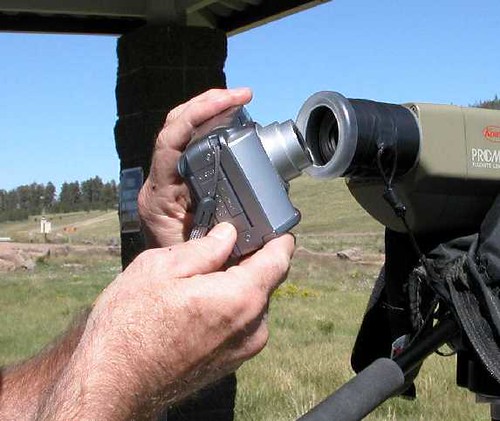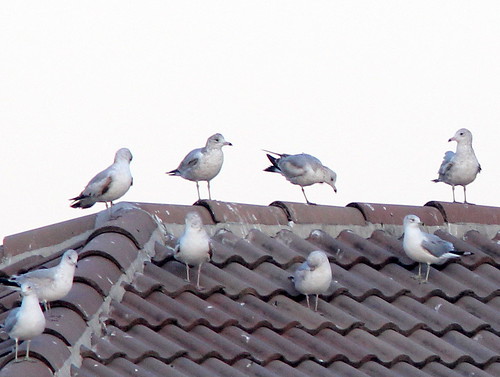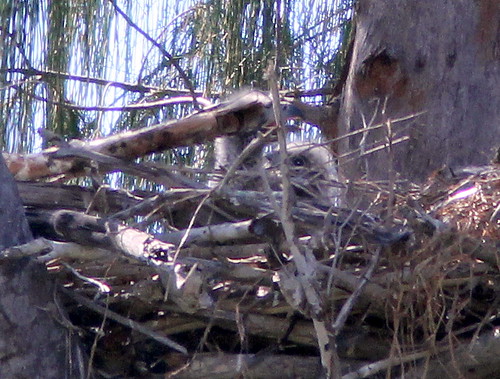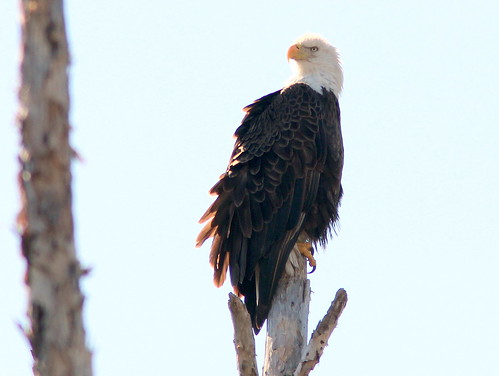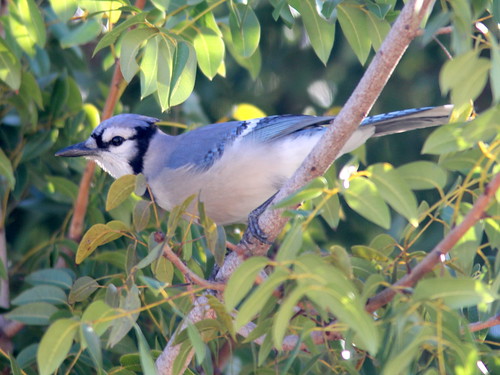Posted by: Ken @ 6:35 pm
My first venture into bird photography occurred in the 1990s when I lived in New Mexico. My simple digiscopic photo equipment consisted of a spotting scope, a 2.0 megapixel point-and-shoot Canon A40 camera, and a Durkee’s spice bottle with the bottom cut to the size of the camera lens housing:
I kept the scope on a tripod in front of the Great Room windows, and documented the birds that visited the front yard pond and feeders. It was too cumbersone to carry around, so all my bird photography was done indoors.
Our New Mexico home had big windows that faced to the west:
The birds were usually only about 30 feet away, but I had to shoot through double-glazed windows. The images often were surrounded by a dark vignette, and had to be cropped, so they ended up being pretty grainy. But to my non-critical eye, they were magnificent. Some examples…
An Evening Grosbeak whose photo lacked feather detail but exuded color and form: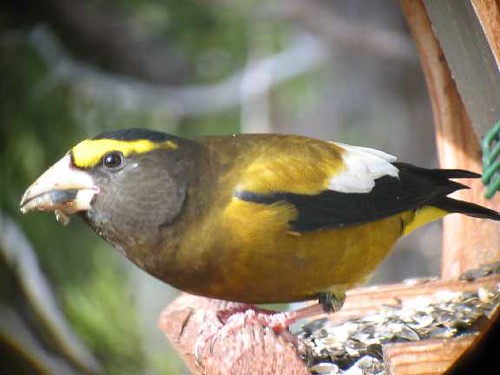
A Northern (Red-shafted) Flicker made up for a lack of megapixels with a grand red mustache: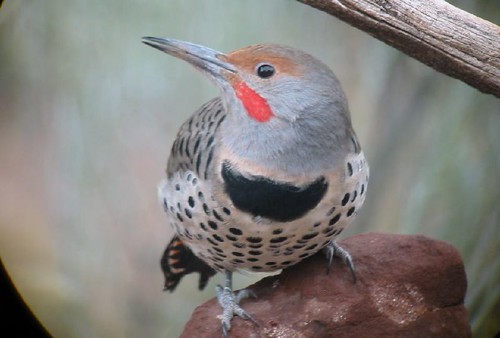
A Blue Grosbeak, on a juniper only feet from our window:
This shot of a Red Crossbill was not a “sale-able image,” but it brings back memories of the bear that had trashed my feeder tray the night before: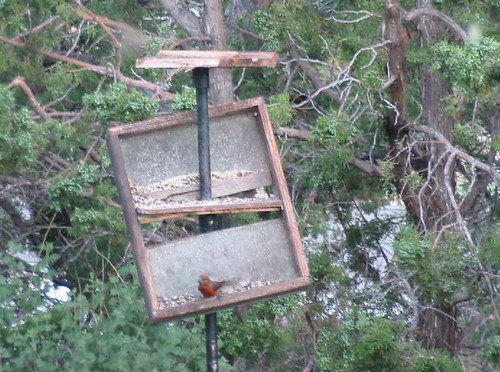
Upon moving to Florida I found the spotting scope to be too powerful for photographing the larger herons, ibises and storks, the most common avian visitors to our backyard lake. I was satisfied to go back to conventional birdwatching with binoculars and spotting scope, and never gave much thought to photography. That is, until 2007, when my son-in-law upgraded his digital SLR equipment from a first-generation 6.3 megapixel Canon EOS Digital Rebel to a 30D that packed 8.2 megapixels.
The Rebel that he gave me was my first digital SLR camera. Immediately, I sunk $180.00 into a Sigma 70-300mm standard zoom lens. It did not have image stabilization, so my long shots were particularly challenging. I tried to steady the camera on the back of a chair when, in December, 2007, a pair of Bald Eagles courted and copulated on the rooftop of a house across the lake, about 520 feet away (according to the ruler in Google Earth). Of the dozen or so photos I took of the couple, only three were recognizable.
Click on the photo to select sequential images:
I realized that the money spent for the Sigma telephoto lens was essentially wasted, unless I wanted to carry a tripod into the field, so my next purchase for my “free” camera cost nearly 10 times as much: a 300mm image stabilized Canon f/4 telephoto with a 1.4x extender. This gave me an effective focal length of 420 mm, about equivalent to 8x power binoculars (Bill Schmoker’s formula says that each 100 mm of focal length adds about 2x power to the eye). Buying a flash unit a few months ago loosened my inhibitions about springing for a camera upgrade, so last month I took a big leap and bought a Canon 60D.
Using the 60D with the 420 image stabilized lens, hand-held, I took this test shot of some gulls on the same rooftop as the eagles (Notice the detail on the tiles, not to mention the brightness of the image and the sharp eyes of the gulls):
Comparing those two shots, I feel good about my latest purchase! We did find the eagles’ nest, which was the very first active nest in Broward County since before DDT was abolished in the early 1970s. They went on to fledge one offspring, and the next year produced two, then, last season, successfully raised three eaglets.
Just this past week, two babies poked their heads above the rim of the nest, and I captured one with my new camera gear:
Eagles begin incubating as soon as the first egg is laid, so the older enjoys a size and strength disparity. The younger chick is the smaller one, peeking at me through the nest structure:
The parent birds stand careful watch over the eaglets. This is the female, distinguished from the male by her larger size:
Here is the male, also roosting nearby. He also happens to have some dark spots on both outer tail feathers, allowing us to know which bird is which:
The male’s small dark outer tail feather spots may be seen in this photo: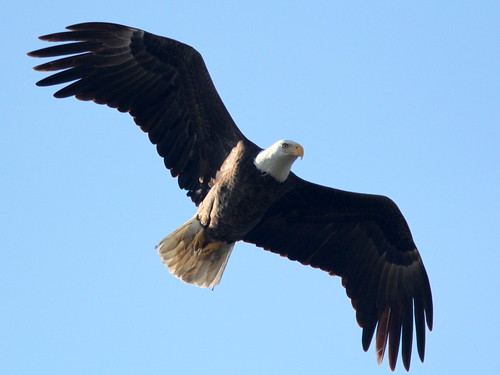
The female eagle’s frown conveys not her frame of mind, but rather, is the permanent product of the bony brow that shades her eyes: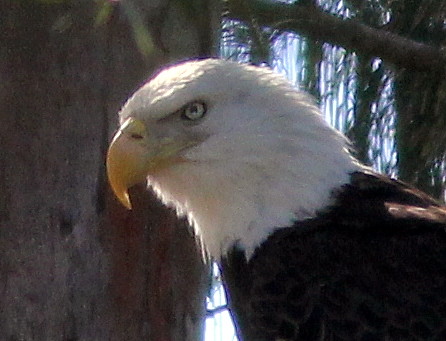
A group of local citizens has been keeping watch on the nest, which is located next to a busy highway only about 1 1/2 miles from our home. I host an Eagle Nest Watch Forum, where the eagle watchers can exchange photos and information, and share the fun with everyone. It has been very popular with the public, attracting over 68,000 views since I started it a little over two years ago. Visit the Forum at http://www.rosyfinch.com/BaldEagleNest.html I even put up my first ever YouTube video clip of one of the chicks, but please turn off the sound, as I had trouble seeing the LCD viewfinder on the 60D, and onlookers were loudly telling me every time the eagle came into sight!
I will tell the full story about the eagles another time, but for me, and for many of my friends and neighbors, our experience with the eagles set us on a much broader path into wildlife photography.
Yesterday, as a sort of throw-back to my New Mexico days, I captured this Blue Jay through our back patio window:













